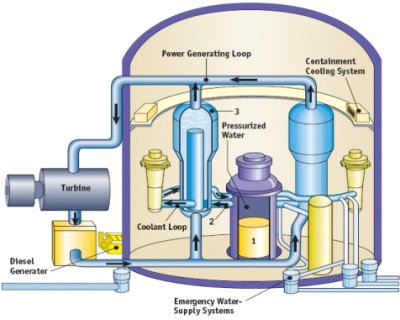Arkansas Nuclear One Power Plant, Arkansas
Next Update: September 2009
Arkansas Nuclear One Generating Station
Net Generation and Capacity, 2007
Unit |
Net Capacity MW(e) |
Generation (Million Kilowatt Hours) |
Capacity Factor (Percent) |
Type | On Line Date |
License Expiration Date |
| 1 | 836 | 7,323.360 | 94.0 | PWR | May 21, 1974 | May 20, 2034* |
| 2 | 988 | 8,654.880 | 99.4 | PWR | Sept. 1, 1978 | July 17, 2038** |
| 1,824 | 15,978.240 | 96.9 | ||||
| PWR = Pressurized Light Water Reactor *On License Extended: The original license for unit 1 expired on May 20, 2014. On June 20, 2001, the U.S. Nuclear Regulatory Commission (NRC) approved the application for license renewal for unit 1, thereby adding 20 years to the license expiration date. An application for unit 2 is currently under review by the NRC. **On July 1, 2005, the NRC extended the license for unit 2. The original license would have expired on July 17, 2018. Source |
||||||
Description: Arkansas Nuclear One (ANO) power plant actually contains two nuclear reactors (the second reactor designated Arkansas Nuclear One unit 2 or ANO-2). The plant is located on a 1,100-acre site in Pope County. In 1967, it was selected as the best site among four candidates. In addition to the easy access to water and availability of rail and highway transportation, the geology was a key factor in its selection. "Below the 20 feet of clay at the site surface is a 150-ft layer of shale and rock which reduced site foundation work to a minimum." 1
Arkansas Nuclear One Unit 1
- Nuclear Steam System Supplier (NSSS Vendor) = Babcock & Wilcox
- Architect Engineer = Bechtel Corporation
- Owner = Entergy Nuclear
- Operator (Licensee) = Entergy Arkansas, Inc.
Arkansas Nuclear One Unit 2
- Nuclear Steam System Supplier (NSSS Vendor) = Babcock & Wilcox
- Architect Engineer = Bechtel Corporation
- Owner = Entergy Nuclear
- Operator (Licensee) = Entergy Arkansas, Inc.
Containment: According to the U.S. Nuclear Regulatory Commission, both reactors are PWR and containment is dry, ambient pressure 2 type.
Pressurized-Water Reactor (PWR)
In a typical commercial pressurized light-water reactor (1) the reactor core generates heat, (2) pressurized-water in the primary coolant loop carries the heat to the steam generator, (3) inside the steam generator heat from the primary coolant loop vaporizes the water in a secondary loop producing steam, (4) the steam line directs the steam to the main turbine causing it to turn the turbine generator, which produces electricity. The unused steam is exhausted to the condenser where it is condensed into water. The resulting water is pumped out of the condenser with a series of pumps, reheated, and pumped back to the steam generator. The reactors core contains fuel assemblies which are cooled by water, which is force-circulated by electrically powered pumps. Emergency cooling water is supplied by other pumps, which can be powered by onsite diesel generators. Other safety systems, such as the containment cooling system, also need power.
 |
| © U.S. Nuclear Regulatory Commission (used with permission). |
_________________________________________
Sources for Data in the Table: Capacity, for purposes of this report, is the net summer capability as reported in Energy Information Administration (EIA) Form EIA-860, "Annual Electric Generator Report." Capacity Factor is a percentage calculation in which the maximum possible generation (based on net summer capability) is divided into the actual generation then multiplied by 100. Generation is the net electricity output reported by plant owners on Form EIA-906, “Power Plant Report.” Type of Unit: All U.S. commercial reactors currently in operation are one of two types: BWR (boiling water reactor) or PWR (pressurized light water reactor). The type, on-line date, and the license expiration date are published annually in Information Digest by the U.S. Nuclear Regulatory Commission.
[1] Construction of Arkansas Nuclear One,' on-line: http://asms.k12.ar.us/armem/terrell/const.htm
[2]Dry Ambient: A reactor containment design whose safety has been evaluated on the basis of having a dry air atmosphere at ambient pressure (0 psig) prior to the onset of a loss of coolant accident or steam pipe break. The containment design (concrete and steel tendons) must be able to take the full thermal and pressure stresses associated with the rapid energy release (steam) from a major pipe break.